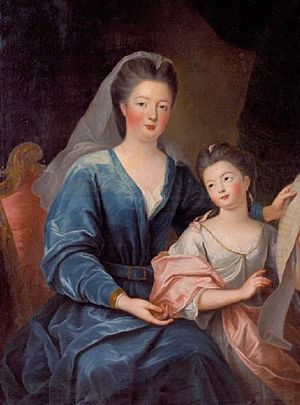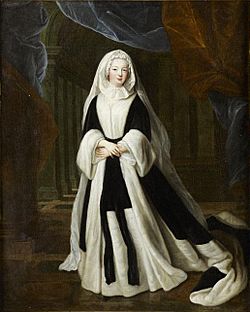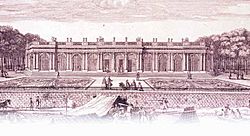Louise Françoise, Princess of Condé facts for kids
Quick facts for kids Louise Françoise |
|
|---|---|
| Princess of Condé Duchess of Bourbon Légitimée de France |
|

Portrait by Pierre Gobert, around 1692
|
|
| Born | 1 June 1673 Tournai, France |
| Died | 16 June 1743 (aged 70) Palais Bourbon, Paris, France |
| Burial | Carmel du faubourg Saint-Jacques, Paris, France |
| Spouse | |
| Issue Detail |
|
| House | Bourbon |
| Father | Louis XIV of France |
| Mother | Françoise-Athénaïs, Marquise de Montespan |
| Signature | |
Louise Françoise, Duchess of Bourbon (born June 1, 1673 – died June 16, 1743) was a French princess. She was the oldest surviving daughter of Louis XIV, the King of France, and his official companion, Françoise-Athénaïs de Rochechouart, Marquise de Montespan. People said she was named after her godmother, Louise de La Vallière. Before she got married, she was known at court as Mademoiselle de Nantes.
Louise Françoise married at age 11. She became known as Madame la Duchesse, a title she kept even after her husband died. Through her marriage, she became the Duchess of Bourbon and Princess of Condé. She was also an important member of a group called the cabale de Meudon, which was led by her half-brother Louis, Grand Dauphin. When her son, Louis Henri, Duke of Bourbon, became the Prime Minister of France, she tried to gain more political power, but it didn't work out much.
Louise Françoise was thought to be very beautiful and had a lively personality. She was often involved in disagreements during her father's reign. Later in her life, she used the money she made from investing with John Law to build the Palais Bourbon in Paris. This building is now where the National Assembly of France meets.
Contents
Early Life (1673–1685)
Louise Françoise was born in Tournai on June 1, 1673. Her parents, King Louis XIV and Françoise-Athénaïs de Rochechouart, Marquise de Montespan, were on a military trip at the time. Her aunt, the Marquise de Thianges, was also there. When they returned from Tournai, her parents placed Louise Françoise and her older siblings in the care of Madame Scarron, a friend of her mother's.
On December 19, 1673, King Louis XIV officially recognized the children he had with his companion. This was done through a legal process approved by the Parlement of Paris. At that time, her oldest brother, Louis-Auguste de Bourbon, became the Duke of Maine. Her next oldest brother, Louis-César de Bourbon, became the Count of Vexin. Louise Françoise received the title of Mademoiselle de Nantes. Her parents called her Poupotte because she looked like a doll.
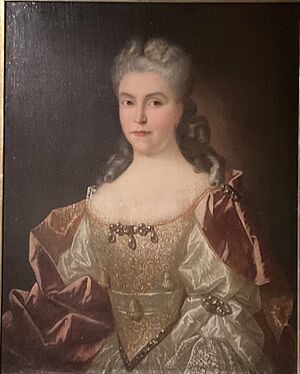
A year after Louise Françoise was born, another sibling joined them in Paris. This was Mademoiselle de Tours, born in November 1674. Mademoiselle de Tours was also officially recognized in 1676. She became a very good friend to Louise Françoise. Louise Françoise was very sad when her younger sister died in 1681.
After Mademoiselle de Tours passed away, Madame de Montespan wrote to the Duc du Maine:
I don't need to tell you about my sadness; you are kind enough to have felt it yourself. As for Mademoiselle de Nantes, she felt it as deeply as if she were twenty. The Queen and Madame la Dauphine visited her.
Mademoiselle de Nantes and Mademoiselle de Tours grew up together in a private house in Paris. The king's children with Madame de Montespan were kept hidden there from the public. Louise Françoise was never very close to her older half-sister, Marie Anne de Bourbon, or her younger full sister, Françoise Marie de Bourbon. The three sisters often felt competitive with each other. Louise Françoise and Françoise Marie especially disliked it when the other gained higher status. However, Louise Françoise was close to her half-brother Louis, Grand Dauphin.
Louise Françoise loved music and dance, just like her parents. She became a very good dancer. When she was nine, she played the role of Youth in a ballet. She also had her mother's quick and sometimes sharp wit. This made her popular with some people but not with others.
Duchess of Bourbon (1685–1710)
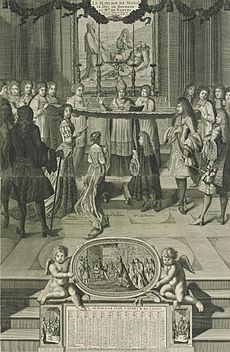
On May 25, 1685, when she was eleven, Louise Françoise married Louis de Bourbon, Duke of Bourbon. He was a distant cousin of her father and was sixteen years old. Her husband was the son of Henry Jules, Duke of Enghien. His mother was Anne Henriette of Bavaria. King Louis XIV gave his daughter a large sum of money, one million livres, for her marriage.
At court, Louise Françoise's husband was known as the duc de Bourbon. People called him Monsieur le Duc. Because of this, his new wife became known as Madame la Duchesse.
In 1686, after her marriage, Louise Françoise got smallpox while the court was at the Palace of Fontainebleau. Her husband, who was seventeen, did not help care for her. However, her mother and her husband's grandfather, Le Grand Condé, did help her. Louise Françoise got better, but Le Grand Condé died the next November after catching her illness. Louise Françoise and her husband had nine children, and all of them lived to be adults.
After her mother officially retired from court in 1691, Louise Françoise often visited her at a convent in Paris. They became much closer, and Louise Françoise was very sad when her mother died in 1707. King Louis XIV did not allow anyone at court to wear mourning clothes for his former companion. But Louise Françoise and her two younger siblings, Françoise Marie de Bourbon and the Count of Toulouse, decided not to attend any court events as a sign of respect for their mother. On the other hand, her older brother, the Duke of Maine, was very happy to inherit his mother's money.
In 1692, her youngest sister, Françoise Marie, married their first cousin, Philippe d'Orléans. He was the only son of their uncle, Monsieur. As the wife of a petit-fils de France (a grandson of France), Françoise Marie was considered more important at court than Louise Françoise and their half-sister Marie Anne. This, along with the fact that Françoise Marie received twice the amount of money for her marriage than Louise Françoise, made Louise Françoise very upset. After this, she became very competitive with her younger sister.
When her husband found out about her close friendship with François Louis de Bourbon, prince de Conti, he was very angry. However, he did not openly argue with the Prince of Conti because he feared King Louis XIV. Her older half-brother, the Dauphin, who she was close to, allowed them to meet at his country estate at Meudon, away from her husband and the court.
When her father-in-law died on April 1, 1709, her husband became the Prince of Condé. However, he did not get the title of Premier Prince du Sang (highest-ranking prince of the royal family). This title was instead given to the House of Orléans. Because of this, her younger sister's husband, the Duke of Orléans, was allowed to use the title Monsieur le Prince. His wife, Louise Françoise's sister Françoise Marie, was then allowed to use the title Madame la Princesse. Even though Françoise-Marie never called herself Madame la Princesse, this change in rank made the rivalry between Louise Françoise and her younger sister even stronger.
Princess of Condé and Widowhood (1710–1740)
Louise Françoise's husband, who had become very ill mentally, died in 1710, not long after his father. Louise Françoise should have officially used the title of Madame la Princesse de Condé douairière (Dowager Princess of Condé) after her husband's death. However, she chose to be known as Madame la Duchesse douairière instead. She had a portrait painted of herself in widow's clothes. When her husband died, people said she was sad, but some, like Madame de Caylus, didn't believe her sadness was real.
Hoping to build a good relationship with the future king, Louise Françoise often visited the court of her older half-brother, Monseigneur, at the Château de Meudon. There, she became close to Élisabeth Thérèse de Lorraine, princesse d'Epinoy, and her older sister, Mademoiselle de Lillebonne. Sadly, the dauphin died unexpectedly in 1711. This ruined Louise Françoise's plan to have a stronger connection with the royal family. Despite her hopes being dashed, Louise Françoise was very sad about the dauphin's death. His death meant that her nephew, Louis, Duke of Burgundy, and his wife, Marie Adélaïde, became the new Dauphin and Dauphine.
Marie Adélaïde and Louise Françoise didn't get along well. This was because the new dauphine looked down on ladies of lower rank. The Duchess of Orléans and the older Dowager Princess of Conti also disliked their niece for her proud behavior.
As a widow, Louise Françoise became a good friend of Jeanne Baptiste d'Albert de Luynes. She was a famous writer of her time.
Within two years, in 1712, the new dauphin and his young wife died. Only a small son, the duc d'Anjou, was left as the official heir of Louis XIV. In 1715, the king died, and his five-year-old great-grandson, Louis XV, became king. A big disagreement immediately happened between Louise Françoise's older brother, the Duke of Maine, and her brother-in-law, the Duke of Orléans. They argued about who should be the Regent (the person who would rule for the young king). After the Parlement of Paris discussed it for a week, the Duke of Orléans was declared the official Regent. This, of course, made the rivalry between Louise Françoise and her younger sister, the Duchess of Orléans, even stronger. The Duchess of Orléans was now the highest-ranking lady in France.
In 1714, her niece, Mademoiselle du Maine, was named in her honor.
In the 1720s, Louise Françoise became very close to the Marquis de Lassay. To be closer to her, he built the Hôtel de Lassay next to the Palais Bourbon, her home in Paris. Later, a gallery was built to connect the two buildings. This allowed them to visit each other more easily.
In 1737, she was asked to be the godmother to Louis XV's oldest son, Louis, Dauphin of France. The young dauphin's godfather was Louise Françoise's nephew, Louis, Duke of Orléans.
When her son faced difficulties during the Regency of Philippe d'Orléans, Louise Françoise blamed his companion, Madame de Prie. Because of this, Louise Françoise disliked her very much. Her son died in exile in 1740. His son, Louise Françoise's grandson, Louis Joseph, Prince of Condé, who was four years old, then took his place.
Palais Bourbon
During her long widowhood, Louise Françoise built the Palais Bourbon in Paris. It was not far from where her surviving brothers and sisters lived. She named it after her family. She got the idea for her new home after visiting the Grand Trianon.
Building the palace started in 1722, when she was forty-nine years old. Several designers worked on it, including Robert de Cotte, Lorenzo Giardini, and Lassurance. Jean Aubert became the main architect in 1726 and is known for the final design. Jacques Gabriel also helped as a consultant.
The Palais had many large rooms for entertaining guests. The main one was the Galerie, which looked out over the Seine river. The main salon of the Palais faced the Tuileries Palace to the east. The Palais was connected to the Hôtel de Lassay by a hallway that overlooked a shared garden.
Her older half-sister, Marie Anne de Bourbon, lived in the Hôtel de Conti, across from the Louvre. Her older brother, the Duke of Maine, owned the Hôtel du Maine (destroyed in 1838), very close to the Palais Bourbon. Her younger sister, the Duchess of Orléans, lived at the Palais-Royal, the Orléans family home in Paris. Near the Louvre and the Palais-Royal, her youngest brother, the Count of Toulouse, lived in the Hôtel de Toulouse. In 1733, her daughter Louise Élisabeth moved into a house very close to the Palais Bourbon. This house became another Hôtel de Conti (now the Hôtel de Brienne).
Death
Louise Françoise de Bourbon died on June 16, 1743, at the age of seventy, at the Palais Bourbon. She was buried at the Carmel du faubourg Saint-Jacques, a convent on the Left Bank in Paris's Latin Quarter.
Children
Louise Françoise had nine children:
| Name | Portrait | Lifespan | Notes | |
|---|---|---|---|---|
| Marie Anne Gabrielle Éléonore de Bourbon Abbess of Saint-Antoine-des-Champs |
 |
22 December 1690 - 30 August 1760 |
Born at the Palace of Versailles; she became an abbess (head of a convent) in her teens; died in Villejuif. In her youth, she was known as Mademoiselle de Condé. | |
| Louis Henri Joseph de Bourbon Duke of Bourbon Prince of Condé |
 |
18 August 1692 - 27 January 1740 |
Born at the Palace of Versailles. He married twice; first to his cousin Marie Anne de Bourbon, and they had no children. He later married Landgravine Caroline of Hesse-Rotenburg and had children. He was the Prime Minister of France during the reign of Louis XV. He died in exile at the Château de Chantilly. | |
| Louise Élisabeth de Bourbon Princess of Conti |
 |
22 November 1693 – 27 May 1775 |
Born at the Palace of Versailles, she married her cousin Louis Armand II, Prince of Conti. She was the grandmother of Philippe Égalité. She died in Paris and lived longer than all her siblings. | |
| Louise Anne de Bourbon Mademoiselle de Charolais |
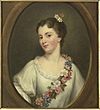 |
23 June 1695 - 8 April 1758 |
Born at the Palace of Versailles, she never married. She was known as Mademoiselle de Sens and then Mademoiselle de Charolais. | |
| Marie Anne de Bourbon Mademoiselle de Clermont |
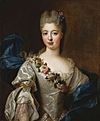 |
16 October 1697 - 11 August 1741 |
Born in Paris. She married Louis de Melun, Duke of Joyeuse, in secret in 1719. She died in Paris after serving Queen Maria Leszczyńska for many years. She was known as Mademoiselle de Clermont. | |
| Charles de Bourbon Count of Charolais |
 |
19 June 1700 - 23 July 1760 |
Born at Chantilly, he was known as the Count of Charolais. When he died, the title went to his sister Louise Anne. He died in Paris. | |
| Henriette Louise Marie Françoise Gabrielle de Bourbon Abbess of Beaumont-lès-Tours |
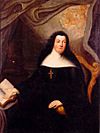 |
15 January 1703 - 19 September 1772 |
Born at the Palace of Versailles, she was once considered as a possible wife for Louis XV, but she never married. She was known as Mademoiselle de Vermandois. She became the abbesse de Beaumont-lès-Tours (head of a convent) from 1728. She died at Beaumont. | |
| Élisabeth Thérèse Alexandrine de Bourbon Mademoiselle de Sens |
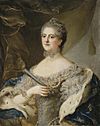 |
15 September 1705 - 15 April 1765 |
Born in Paris, she was known as Mademoiselle de Sens. Her large fortune went to her nephew, Louis Joseph de Bourbon, who would become the Prince of Condé. | |
| Louis de Bourbon Count of Clermont |
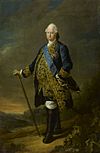 |
15 June 1709- 16 June 1771 |
Born at the Palace of Versailles, he was the Count of Clermont from birth. He never married and died at Versailles. He started the Académie du Petit-Luxembourg, where scientists, artists, and architects would meet. |
Ancestry
| Ancestors of Louise Françoise, Princess of Condé | |||||||||||||||||||||||||||||||||||||||||||||||||||||||||||||||||||||||||||||||||||||||||||||||||||||||||||||||||||||||||||||||||||||||||||||||||||||||||||||||||||||||||||||||||||||||||||||||||||||||||||||||||||||||||||||||||||||||||||||||||||||||||||||||||||||||||||||||||||||||||
|---|---|---|---|---|---|---|---|---|---|---|---|---|---|---|---|---|---|---|---|---|---|---|---|---|---|---|---|---|---|---|---|---|---|---|---|---|---|---|---|---|---|---|---|---|---|---|---|---|---|---|---|---|---|---|---|---|---|---|---|---|---|---|---|---|---|---|---|---|---|---|---|---|---|---|---|---|---|---|---|---|---|---|---|---|---|---|---|---|---|---|---|---|---|---|---|---|---|---|---|---|---|---|---|---|---|---|---|---|---|---|---|---|---|---|---|---|---|---|---|---|---|---|---|---|---|---|---|---|---|---|---|---|---|---|---|---|---|---|---|---|---|---|---|---|---|---|---|---|---|---|---|---|---|---|---|---|---|---|---|---|---|---|---|---|---|---|---|---|---|---|---|---|---|---|---|---|---|---|---|---|---|---|---|---|---|---|---|---|---|---|---|---|---|---|---|---|---|---|---|---|---|---|---|---|---|---|---|---|---|---|---|---|---|---|---|---|---|---|---|---|---|---|---|---|---|---|---|---|---|---|---|---|---|---|---|---|---|---|---|---|---|---|---|---|---|---|---|---|---|---|---|---|---|---|---|---|---|---|---|---|---|---|---|---|---|---|---|---|---|---|---|---|---|---|---|---|---|---|---|---|---|
|
|||||||||||||||||||||||||||||||||||||||||||||||||||||||||||||||||||||||||||||||||||||||||||||||||||||||||||||||||||||||||||||||||||||||||||||||||||||||||||||||||||||||||||||||||||||||||||||||||||||||||||||||||||||||||||||||||||||||||||||||||||||||||||||||||||||||||||||||||||||||||
Images for kids
-
Older half-sister Marie Anne de Bourbon
-
Younger sister Françoise Marie de Bourbon (left) and Louise Françoise (right)
See also
 In Spanish: Luisa Francisca de Borbón para niños
In Spanish: Luisa Francisca de Borbón para niños


